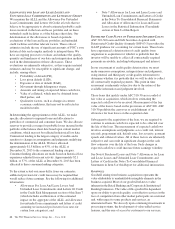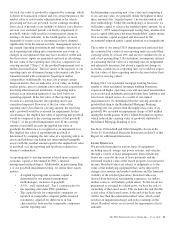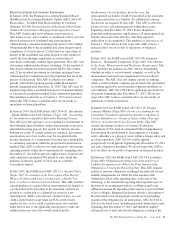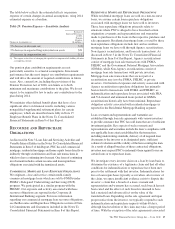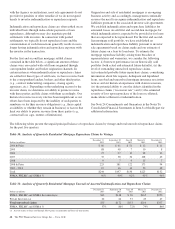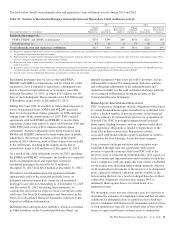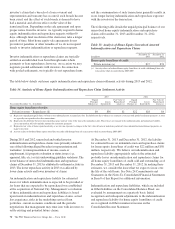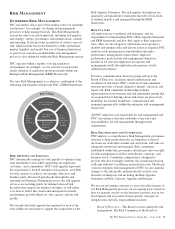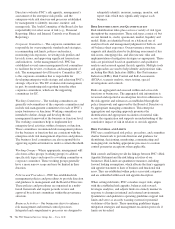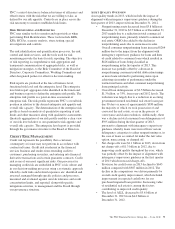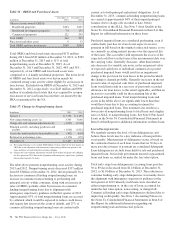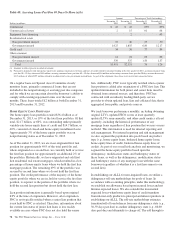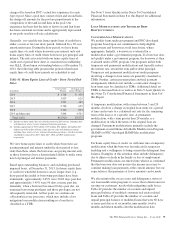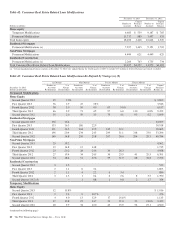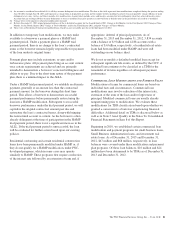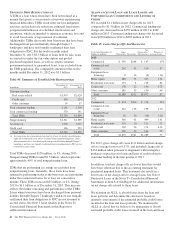PNC Bank 2013 Annual Report Download - page 90
Download and view the complete annual report
Please find page 90 of the 2013 PNC Bank annual report below. You can navigate through the pages in the report by either clicking on the pages listed below, or by using the keyword search tool below to find specific information within the annual report.Directors evaluates PNC’s risk appetite, management’s
assessment of the enterprise risk profile, and the
enterprise-wide risk structure and processes established
by management to identify, measure, monitor, and
manage risk. The Audit Committee of the Board also has
responsibility for select areas of risk (e.g., Financial
Reporting, Ethics and Internal Controls over Financial
Reporting).
Corporate Committees – The corporate committees are
responsible for overseeing risk standards and strategies,
recommending risk limits, policies and metrics,
monitoring risk exposures, reviewing risk profiles and
key risk issues, and approving significant transactions
and initiatives. At the management level, PNC has
established several senior management-level committees
to facilitate the review, evaluation, and management of
risk. The management-level Executive Committee (EC)
is the corporate committee that is responsible for
developing enterprise-wide strategy and achieving PNC’s
strategic objectives. The EC evaluates risk management,
in part, by monitoring risk reporting from the other
corporate committees, which are the supporting
committees for EC.
Working Committees – The working committees are
generally subcommittees of the corporate committees and
include risk management committees for each of PNC’s
major businesses or functions. Working committees are
intended to define, design and develop the risk
management framework at the business or function level.
The working committees help to implement key
enterprise-level activities within a business or function.
These committees recommend risk management policies
for the business or function that are consistent with the
enterprise-wide risk management objectives and policies.
The business level committees are also responsible for
approving significant initiatives under a certain threshold.
Working Groups – Where appropriate, management will
also form ad hoc groups (working groups) to address
specific risk topics and report to a working committee or
corporate committee. These working groups generally
have a more narrow scope and may be limited in their
duration.
Policies and Procedures – PNC has established risk
management policies and procedures to provide direction
and guidance to management and the Board of Directors.
These policies and procedures are organized in a multi-
tiered framework and require periodic review and
approval by relevant committees within the governance
structure.
Business Activities – Our businesses strive to enhance
risk management and internal control processes.
Integrated and comprehensive processes are designed to
adequately identify, measure, manage, monitor, and
report risks which may significantly impact each
business.
R
ISK
I
DENTIFICATION AND
Q
UANTIFICATION
Risk identification takes place across a variety of risk types
throughout the organization. These risk types consist of, but
are not limited to, credit, operational, market, liquidity and
model. Risks are identified based on a balanced use of
analytical tools and management judgment for both on- and
off-balance sheet exposures. Our governance structure
supports risk identification by facilitating assessment of key
risk issues, emerging risks, and idiosyncratic risks and
implementation of mitigation strategies as appropriate. These
risks are prioritized based on quantitative and qualitative
analysis and assessed against the risk appetite. Multiple tools
and approaches are used to help identify and prioritize risks,
including Key Risk Indicators (KRIs), Key Performance
Indicators (KPIs), Risk Control and Self-Assessments
(RCSAs), scenario analysis, stress testing, special
investigations and controls.
Risks are aggregated and assessed within and across risk
functions or businesses. The aggregated risk information is
reviewed and reported at an enterprise level for adherence to
the risk appetite and tolerances as established through the
policy framework and approved by the Board of Directors or
by appropriate managing committees. This enterprise
aggregation and reporting approach promotes the
identification and appropriate escalation of material risks
across the organization and supports an understanding of the
cumulative impact of risk in relation to our risk appetite.
R
ISK
C
ONTROL AND
L
IMITS
PNC uses a multi-tiered risk policy, procedure, and committee
charter framework to provide direction and guidance for
identifying, decisioning, monitoring, communicating and
managing risk, including appropriate processes to escalate
control parameter exceptions when applicable.
Risk controls and limits provide the linkage between PNC’s Risk
Appetite Statement and the risk taking activities of our
businesses. Risk Limits are quantitative measures, including
forward looking assumptions, which allocate the firm’s aggregate
risk appetite statement to lines of business and functional risk
areas. They are established within policy across risk categories
and are embedded within each risk appetite description.
When setting risk limits, PNC considers major risks, aligns
with the established risk appetite, balances risk-reward,
leverages analytics, and adjusts limits in a timely manner in
response to changes in internal and external environments.
Quantitative and qualitative operating guidelines support risk
limits and serve as an early warning system for potential
violations of the limits. These operating guidelines trigger
mitigation strategies and management escalation protocols if
limits are breached.
72 The PNC Financial Services Group, Inc. – Form 10-K


